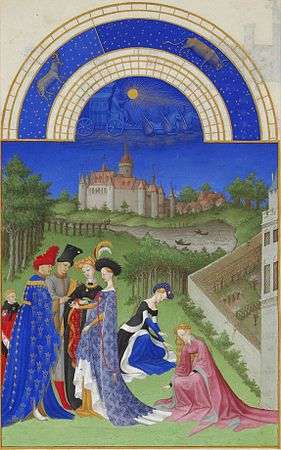Houppelande
A houppelande or houpelande is an outer garment, with a long, full body and flaring sleeves, that was worn by both men and women in Europe in the late Middle Ages. Sometimes the houppelande was lined with fur. The garment was later worn by professional classes, and has remained in Western civilization as the familiar academic and legal robes of today.
The houppelande appeared around 1380 and was to remain fashionable well into the next century.[1] It had its origins in the herigaut, a similar 13th-century garment with hanging sleeves.[2] The edges of the houppelande were often dagged, or cut into decorative patterns such as scallops, "embattled" tabs or even leaf shapes.[3]
 Woman wearing a houppelande with "dagged" sleeves.
Woman wearing a houppelande with "dagged" sleeves. The man on the right wears a belted houppelande and a chaperon hat.
The man on the right wears a belted houppelande and a chaperon hat. Houppelande examples from Très Riches Heures du Duc de Berry, avril
Houppelande examples from Très Riches Heures du Duc de Berry, avril
See also

15th century costume - the Houppelande
| Wikimedia Commons has media related to Houppelande. |
Notes
- ↑ Laver, Concise History of Costume and Fashion
- ↑ Howell, Lauren. "Early Gothic-13th & 14th Centuries". Illinois State University. Retrieved 18 July 2013.
- ↑ Ribiero, Aileen, Dress and Morality, Batsford, 1986, reprinted Berg, 2003, ISBN 1-85973-782-X
References
- Ribiero, Aileen, Dress and Morality, Batsford, 1986, reprinted Berg, 2003, ISBN 1-85973-782-X
- Laver, James: The Concise History of Costume and Fashion, Abrams, 1979.
This article is issued from Wikipedia - version of the 7/25/2016. The text is available under the Creative Commons Attribution/Share Alike but additional terms may apply for the media files.